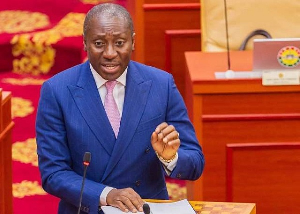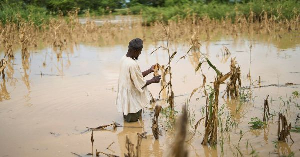*By: Lepowura M. N. D. Jawula
As we shop around the streets of Accra whether as housewives, government officials or tourists, it ought to dawn on us that on a daily basis and hour by hour and minute by minute we are glossing over a serious criminality. The kayaye who are mainly young girls under the age of eighteen (18) and who do head porterage can be seen clearly carrying various food and hardware items on their heads. If they were merely engaging in external household chores as part of their domestic training and upbringing, it shouldn’t raise any eyebrows. The kayaye of Accra however are really child labourers who have travelled mainly from various Northern abodes to Accra in search of work.
The history of labour emerging from the north to Accra and other southern parts is as old as the Gold Coast itself that preceded Ghana. Labour was recruited from the north to the south to work on cocoa farms, in the mining areas and even for enlistment into the Ghana Police Service and the Army with the latter being as a result of the proverbial height of northern people which was seen as an advantage for policing in particular. Starting with people from the Builsa area. Overtime, because of the predominance of police men from Kanjarga, it was assumed that every Builsa came from Kanjarga and by extension, every Northerner also came from Kanjarga. But these movements were about able bodied men freely recruited of their own accord to work for a living and look after their families. Naturally, a certain aspect of migration would have evolved out of this because some people decided to retire and live in the south and perhaps give their children an advantage of a better education in southern schools. This was to be expected because the only secondary school in the entire north was started in Tamale in 1951. The next batch of schools were the then Ghana Educational Trust Secondary Schools fashioned out in the mould of Navrongo Secondary School which got started in 1960 and Bawku Secondary and Ghana College, Tamale which followed in 1961. It appears clear therefore that migration in that regard was meant to give advantage to the children of these patriotic and able bodied men who had worked in the south and seen what advantages education could bring.
However, there is this aspect of migration of child labour which is wrong and offends International Law, the 1992 Constitution, the Labour Act 2003, Act 651, the Children’s Act 1998, Act 580 and the basic human rights of the culprits.
The concept of child labour has been defined as the using of legal perspectives of who a child is. According to the 1992 Constitution of Ghana a child is anyone under the age of eighteen (18) years. Given the definition of a child, the ILO convention 138 defines child labour as “labour that is performed by a child who is under the minimum age for the kind of work (as defined by national legislation, in accordance with accepted international standards) and that is those likely to impede the child’s education and full development”. Child labour therefore depends on the child’s age, types of work performed, conditions or environment under which the work is performed, tools used and the number of hours worked. Working children are frequently exposed to jobs that are morally or psychologically damaging, hours that are excessive, conditions that are unsafe, employment contracts that equate with slavery or, at least economic exploitation.
Recent statistics about child labour as reported by the ILO (2002) indicate that 246 million children are child labourers, 73 million working children are less than ten (10) years old; every year, 22,000 children die in work related accidents and the highest proportion of working children are in Sub-Saharan Africa, where nearly one third of children aged fourteen (14) and under (48 million children) are in the labour force. The report also states that among all the world’s working children, most are in the informal sector where they do not have legal or regulatory protection. This phenomenon of children engaging in work that adversely affected their physical, psychological and normal development reached frightening proportions about a decade and a half ago. Such types of child labour also represented a violation of the rights of children.
In 1999, nations of the world reached a global agreement to tackle and indeed eliminate the phenomenon, especially in its worst forms. Under the auspices of the International Labour Organisation (ILO), a new international human rights instrument, Convention (No. 182) targeted at the elimination of the Worst forms of Child Labour (WFCL) was adopted. The Convention defines the worst forms of child labour as the engagement of children under eighteen (18) years in all forms of slavery and similar practices, prostitution and pornography, illicit activities and hazardous work; and work which by its nature or the circumstances in which it is carried out, is likely to harm the health, safety or morals of children. The Convention provides that hazardous work shall be defined by the competent national authority, after consultation with organizations of employees and workers.
Given the widespread nature of the phenomenon, the actual numbers are unknown. Ghana Child Labour Survey (GCLS 2003) undertaken by the Ghana Statistical Service, gives the most credible information on the dimensions of the problem. The results show that out of an estimated 6.36 million children aged 15-17 years, 2.47 million (half of rural children and one-fifth of urban children) were engaged in paid economic activity. About two-thirds of children (68.7%) did no work, of which 80.5% were at school full-time, while an estimated 1.59 million were combining school with work. Nearly 20% of children (about 1.27 million) were engaged in activities classified as child labour. On the basis of the Children’s Act, the GCLS considered as child labour “children under thirteen (13) who worked, children of all ages who worked at night (8:00pm – 6:00am), and children who engaged in economic activity which affect school attendance, health and the moral development of children” (GCLS, p. 8).
The GCLS estimates that significant numbers of children are in activities regarded as WFCL, including child domestic work, fishing, head porters, commercial sexual exploitation, customary or ritual servitude, small scale mining and quarrying, and commercial agriculture. Some are found in urban informal economies, in transportation, traditional restaurants, begging and especially, petty trading, with street children becoming an increasingly visible phenomenon in the main cities. More than 242,000 children are engaged in hazardous child labour and puts child labourers aged below thirteen (13) years at 1,031,220. According to the GCLS, about 1.3 million of the 24.7 million working children are part time workers. Eighty-eight percent (88%) of them were unpaid family workers and apprentices, while 5.9% were self employed. As these estimates show, large numbers of children below age fifteen (15) are engaged in activities spanning most sectors of the economy, with significant proportions even in non-agricultural activities. Working children are found in all the regions of the country, though there are regional differentials in the prevalence.
As cited above, am estimated number of 242,074 children are engaged in hazardous child labour. There is broad agreement among stakeholders about the prevalence of several WFCL, including child trafficking, head porterage (kayaye), child domestic servitude, ritual servitude (the Trokosi system), commercial sexual exploitation of children, quarrying and galamsey (small scale mining), street children, fishing and commercial agriculture. Eliminating these WFCL calls for a carefully crafted advocacy strategy with a broad social acceptance as a complement to the existing policy and legal framework. Various factors have been associated with the phenomenon of child labour in Ghana. Some of these include poverty, lack of parental care and peer influence (CSPS 2006)
All forms of child labour are offensive and unacceptable. The majority of these appear to be on the blind side of Ghanaians but even then, we have all been witnesses to the harm that child labour on cocoa farms has done to Ghana’s image in the immediate past. Suffice to say, that this aspect of child labour is being sorted out by COCOBOD and other authorities.
Kayaye however, is visible, its about children spanning ages 8 – 15 years. They do not attend school, they face severe health hazards, they live in squalor and some drift toward night work which has serious connotations on sex work. Whatever the kayaye are involved in have also implications on breaches on the 1992 Constitution with respect to the right to life (Article 13), personal liberty (Article 14), right to human dignity (Article 15) and equality and freedom from discrimination (Article 17). The Children’s Act has several references to the protection of the child particularly Section 87 which states that: 1) No person shall engage a child in exploitive labour
2) Labour is exploitive of a child if it deprives the child of his/her health, education and development
There are therefore serious concerns that infringe on the laws of Ghana as well as International Law and yet we look on as if we cannot solve the problem associated thereof. The memorandum to the Savanna Accelerated Development Bill makes reference to this problem in paragraph 3 and in the debate in Parliament, Hon. Ambrose Dery, MP for Lawra/Nandom stated categorically “Because of the economic backwardness; what has happened is that there is a movement of the people from the North to the South and as I speak to you, an example is Upper West Region. Only 49.7 per cent of the Upper West Region population is in Upper West Region. The majority of Upper Westerners, 50.3 per cent, is outside Upper West Region”. If what the Honourable MP has said samples the prevailing conditions affecting the three Northern Regions, then there is work to do in Ghana to reverse the migratory trends and to put a halt to kayaye.
We cannot solve these problems without reference to regulatory authorities generally in Ghana. Most things work in Ghana except those that require regulation. People park under no parking signs, people sell on pavements, people throw garbage around and the level of misconduct could be endless yet city authorities who should enforce regulations say they have no funds to operate with. Meanwhile, all these offences attract fines that could create liquidity for the assemblies. The Children’s Act empowers District Assemblies, the Police and the Department of Social Welfare to act as appropriate when children are being abused by being rushed into dehumanizing work and yet the kayaye are strewn across the streets of Accra and other urban areas carrying overloaded merchandise and impugning upon the integrity of womanhood. I worry for Ghana in this particular area because as I travel around African countries generally, I do no see the practise of this phenomenon; female head porterage on a massive scale as I see in this country. To a certain extent we can say we are doing well because we have a female Chief Justice, a female Speaker of Parliament and a female Attorney General and Minister of Justice but that is just one side of the equation. These practices will not enable kayaye out of the blue to qualify where it matters as female legislators, for instance. Figures from the Inter Parliamentary Union indicate that 51% parliamentary representation in Rawanda are women with 46% in Sweden, 43% in Cuba, 43% in Iceland and 43% in South Africa. This is where it matters most and yet out of 49 Constituencies in the three Northern Regions, only two (2) are women.
These development matters need to be taken seriously by all Political Parties, Civil Society Organizations, NGO’s, Development Partners, Bilateral and Multilateral Organizations and particularly by Women Advocacy Groups. I know there are a lot of men who want to help but this is a particular area we want leadership to emerge for the women of Ghana and Africa. The issue of child trafficking has been very topical in the past few weeks and months and I know my good friend Hon. Mark Wayongo is having sleepless nights over these issues but I believe that these interjections are only a tip of the iceberg. We need a holistic national solution with dedicated debates in the Legislature because some of these problems have their genesis in the pre independence debates of the Legislative Assembly. On the 11th of February 1954, the then Minister of Finance made what I consider to be an unambiguous remark in the Legislative Assembly.
He said inter alia,
“…I would like to touch on a point which runs all the way through a great number of speeches from the Honourable Members from the Northern Territories. They have complained that there is not a fair distribution of our wealth in order to improve their lot in the Northern Territories…. One of the problems we have had to face again and again, I think, has been the desire that this government should have a Development Plan like some Aladdin’s Lamp which can be rubbed to produce everything all at once. It can not be done. And it most unfortunate for the Northern Territories that development had to take place further South in order to produce development in due course in the Northern Territories.”
This is the bane of Ghana’s development and these precepts have led to under development in the North and which have led to legitimate migration of adults in the past and now to illegitimate migration of infants in the present. I can say without any risk of contradiction that several governments of this country haven imbibed policy failures of the nature of this Minister of 1954 have led to the calamity of child labour in general and kayaye in particular. The Acheampong era Agricultural policies were good for the North and the people of the North recount those policies with nostalgia because the wind of Operation Feed Yourself swept from the sugar plantation farms of Komenda and Asutuare to the rice fields spanning Katanga in Gonja, Demon and Diare in Dagbon and to the Fumbisi Valley in the Northern and Upper East Regions. In the true economic concept of Comparative Advantage, there was work to do at home so the notion of migration never became an issue. I know jobs are difficult to come by but if we improve upon agriculture and have the forward and backward linkages that will re-establish the rice mills as well as the oil mills, tomato and meat factories, I believe a step would have been taken in the right direction.
*The Author is a Social Policy Analyst
Opinions of Wednesday, 1 September 2010
Columnist: Jawula, Lepowura M. N. D.














